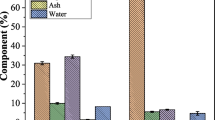Abstract
Aspergillus sp. NR-4201 was assessed by degrading glucosinolates in brownmustard seed meal (Brassica juncea). A liquid culture of the strain, in a medium derived from the meal, produced total degradation of glucosinolates at 32 h. Under these conditions, the glucosinolate-breakdown product, allylcyanide, was formed inculture filtrates. In a plate culture under sterile conditions, the growth of the strain inheat-treated meal media was shown to be effective at 30 °C with 51% moisture,as determined by the measurement of the colony growth rate. On the laboratory scale,solid-state culture under the same conditions gave rise to total glucosinolate degradationwithin 48 h. In comparison, under non-sterile conditions in either heat-treated or nonheat-treated meal samples, the degradations were complete after 60 and 96 h, respectively.In these cases, growth was associated with some out-growths of contaminating fungi,mainly Rhizopus sp. and Mucor sp. The glucosinolate-breakdown product,allylcyanide, was not detected in the solid-state meal-media culture presumably due toevaporative loss from the fermentation matrix.
Similar content being viewed by others
References
Anon (1991) The state of food and agriculture. Food and Agriculture Organization (FAO): Production year books 1970-1990, Rome
AOAC (1990) Protein (crude) in animal feed: copper catalyst Kjeldahl method. In: Official methods of analysis of AOAC international (pp 74). 15th ed. Virginia
Ballester D, Rodrigo R, Nakouzi J, Chichester CO, Yanez E & Monckberg F (1970) Rapeseed meal III: A simple method for detoxification. J. Food Sci. Agri. 21: 143-144
Bones AM & Rossiter JT (1996) The myrosinase-glucosinolate system, its organisation and biochemistry. Physiol. Plant. 97: 194-208
Brabban AD & Edwards C (1994) Isolation of glucosinolate degrading microorganisms and their potential for reducing the glucosinolate content of rapemeal. FEMS Microbiol. Lett. 119: 83-88
Fenwick GR, Heaney RK & Mullin WJ (1983) Glucosinolates and their breakdown products in foods and food plants. CRC Crit. Rev. Food Sci. Nutr. 18: 123-201
Hill R. (1979) A review of the toxic effects of rapeseed meals with observation on meal from improved varieties. Br. Vet. J. 135: 3-14
Isshiki K, Tokuoka K, Mori R & Chiba S (1992) Preliminary examination of allylisothiocyanate vapor for food preservation. Biosci. Biotech. Biochem. 56: 1476-1477
Maheswari PN, Stanley DW & Gray JI (1981) Detoxification of rapeseed products. J. Food Protect. 44: 459-470
Nugon-Baudon L, Rabot S, Wal JM & Szylit O (1990) Interactions of the intestinal microflora with glucosinolates in rapeseed meal toxicity: First evidence of an intestinal Lactobacillus possessing a myrosinase-like activity in vitro. J. Sci. Food Agri. 52: 547-559
Nugon-Baudon L, Szylit O & Raibaud P (1988) Production of toxic glucosinolate derivatives from rapeseed meal by intestinal microflora of rat and chicken. J. Sci. Food Agri. 43: 299-308
Oginsky EL, Stein EA & Greer MA (1965) Myrosinase activity in bacteria as demonstrated by the conversion of progoitrin to goitrin. Proc. Soc. Exp. Med. 119: 360-364
Ohlson R (1972) Projection and prospects for rapeseed and mustard seed. J. Am. Chem. Soc. 49: 522-526
Palop ML, Smits JP & Brink BT (1995) Degradation of sinigrin by Lactobacillus agilis R16. Int. J. Food Microbiol. 265: 219-229
Pandey A (1992) Recent process developments in solid-state fermentation. Process Biochem. 27: 109-117
Pons WA & Goldblatt LA (1965) The determination of aflatoxin in cotton seed products. J. Am. Oil Chem. Soc. 42: 471-475
Rakariyatham N (2000) The value added by-products from mustard essential oil plants. In: reports to Thailand Research Fund. Chiang Mai
Rauchberger Y, Mokady S & Cogan U (1979) The effect of aqueous leaching of glucosinolates on the nutritive quality of rapeseed meal. J. Food Sci. Agri. 30: 31-39
Sakorn P, Rakariyatham N, Niamsup H & Kovitaya P (1999) Sinigrin degradation by Aspergillus sp. NR-4201 in liquid culture. Science Asia 25: 189-194
Sakorn P, Rakariyatham N, Niamsup H & Nungkunsarn P (2002) Rapid detection of myrosinase-producing fungi: A plate method based on opaque barium sulphate formation. World J. Microbiol. Biotechnol. 18: 73-74
Shahidi F, Naczk M, Rubin LJ & Diosady L (1988) A novel processing approach for rapeseed and mustard seed-removal of undesirable constituents by methanol-ammonia. J. Food Protect. 51: 743-749
Smits JP, Janssens RJJ, Knol W & Bol J (1994). Modelling of the glucosinolate content in solid-state fermentation of rapeseed meal with fuzzy logic. J. Ferm. Bioeng. 77: 579-581
Smits JP, Knol W & Bol J (1993) Glucosinolate degradation by Aspergillus clavatus and Fusarium oxysporum in liquid and solid state fermentation. Appl. Microbiol. Biotechnol. 38: 696-701
Sosulski FW & Sarwar G (1973) Amino acid composition of oilseed meals and protein isolates. Can. Inst. Food Sci. Technol. J. 6: 1-5
Van Megen WH (1983) Removal of glucosinolates from defatted rapeseed meal by extraction with aqueous ethanol. Can. Inst. Food Sci. Technol. J. 16: 93-96
Wilkinson AP, Rhodges MJC & Fenwick GR (1984) Determination of myrosinase (thioglucoside glucohydrolase) activity by spectrophotometric coupled enzyme assay. Anal. Biochem. 139: 284-291
Author information
Authors and Affiliations
Rights and permissions
About this article
Cite this article
Rakariyatham, N., Sakorn, P. Biodegradation of glucosinolates in brown mustard seed meal (Brassica juncea) by Aspergillus sp. NR-4201 in liquid and solid-state cultures. Biodegradation 13, 395–399 (2002). https://doi.org/10.1023/A:1022851129684
Issue Date:
DOI: https://doi.org/10.1023/A:1022851129684




